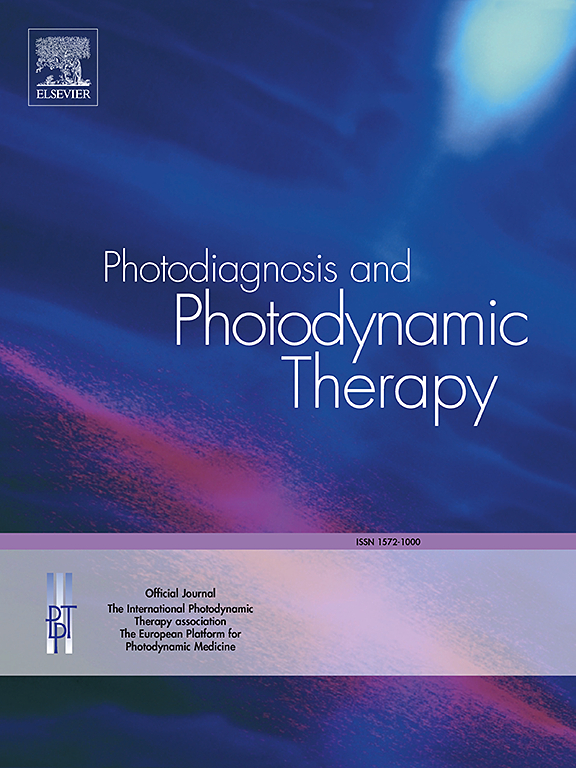Assessment of bimodal laser photodynamic therapy at wavelenths of 410 nm and 653 nm for oral precancerous lesions: An in vitro and in vivo study
IF 3.1
3区 医学
Q2 ONCOLOGY
引用次数: 0
Abstract
Background
Oral mucosal leukoplakia, a prevalent precancerous condition, poses significant challenges in clinical management. Photodynamic therapy (PDT) is a common therapeutic strategy, its efficacy in clinical practice is often constrained. There is a pressing demand for innovations that can enhance the effectiveness of PDT and minimize its side effects in addressing oral precancerous lesions.
Materials and methods
This study employed m-THPC as a photosensitizer and developed a novel light source with dual wavelengths of 410 nm/653 nm tailored to excite the photosensitizer. We conducted photodynamic experiments using oral precancerous cell lines, OSCC cell line and animal models. In vitro cellular responses were assessed using colony formation, and cell apoptosis assays. An oral precancerous mouse model was established to appraise the therapeutic efficacy of the treatments. Histopathological evaluation of apoptosis was performed using TUNEL and immunohistochemical staining.
Results
The development of a dual-wavelength laser device is reported. m-THPC demonstrated an affinity for precancerous cells, preferentially accumulating in precancerous tissue in vitro. Activation of m-THPC with a 410 nm laser showed a robust photochemical effect, effectively inhibiting the proliferation and promoting the apoptosis of precancerous cells in vitro. The combined application of 410 nm/653 nm wavelengths yielded superior therapeutic efficacy, compared to the individual emissions at 410 nm and 653 nm, in a precancerous lesion mouse model and was associated with fewer adverse reactions. Despite spectral mismatch with m-THPC, high-dose 532 nm irradiation achieved therapeutic efficacy comparable to dual-wavelength PDT in vivo. However, this dose-dependent enhancement was accompanied by exacerbated photothermal effects, resulting in significant adverse reactions including localized hyperthermia and nonspecific tissue damage.
Conclusion
The dual-wavelength PDT, optimized for m-THPC, exhibits superior photodynamic characteristics and excellent biosafety. It aligns well with realistic clinical applic ation scenarios and presents as an innovative and promising therapeutic modality for the treatment of oral leukoplakia.

410 nm和653nm波长双峰激光光动力治疗口腔癌前病变的评估:一项体外和体内研究。
背景:口腔黏膜白斑是一种常见的癌前病变,在临床治疗中提出了重大挑战。光动力疗法(PDT)是一种常用的治疗策略,但其在临床实践中的效果往往受到限制。迫切需要创新,以提高PDT的有效性,并尽量减少其副作用,以解决口腔癌前病变。材料和方法:本研究采用m-THPC作为光敏剂,并开发了一种新型光源,该光源具有410 nm/ 653nm双波长,可激发光敏剂。我们利用口腔癌前细胞系、OSCC细胞系和动物模型进行了光动力学实验。体外细胞反应通过集落形成和细胞凋亡测定来评估。建立口腔癌前小鼠模型,评价其治疗效果。采用TUNEL和免疫组织化学染色对细胞凋亡进行组织病理学评价。结果:报道了双波长激光器件的研制。m-THPC显示出对癌前细胞的亲和力,在体外优先在癌前组织中积累。410 nm激光活化m-THPC具有较强的光化学效应,能有效抑制癌前细胞的增殖,促进癌前细胞的凋亡。在癌前病变小鼠模型中,与410nm和653nm单独发射相比,410nm / 653nm波长的联合应用产生了更好的治疗效果,并且不良反应较少。尽管与m-THPC的光谱不匹配,高剂量532nm照射在体内获得了与双波长PDT相当的治疗效果。然而,这种剂量依赖性增强伴随着加剧的光热效应,导致显著的不良反应,包括局部高热和非特异性组织损伤。结论:对m-THPC优化后的双波长PDT具有良好的光动力学特性和良好的生物安全性。它与实际临床应用场景相吻合,是一种创新的、有前景的口腔白斑治疗方式。
本文章由计算机程序翻译,如有差异,请以英文原文为准。
求助全文
约1分钟内获得全文
求助全文
来源期刊

Photodiagnosis and Photodynamic Therapy
ONCOLOGY-
CiteScore
5.80
自引率
24.20%
发文量
509
审稿时长
50 days
期刊介绍:
Photodiagnosis and Photodynamic Therapy is an international journal for the dissemination of scientific knowledge and clinical developments of Photodiagnosis and Photodynamic Therapy in all medical specialties. The journal publishes original articles, review articles, case presentations, "how-to-do-it" articles, Letters to the Editor, short communications and relevant images with short descriptions. All submitted material is subject to a strict peer-review process.
 求助内容:
求助内容: 应助结果提醒方式:
应助结果提醒方式:


